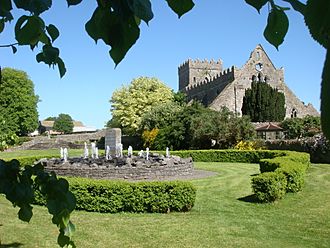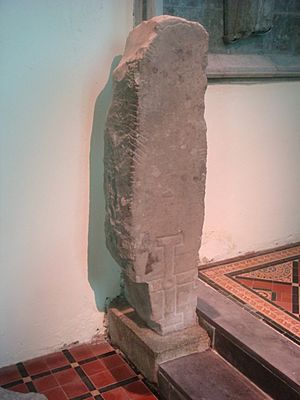St. Mary's Collegiate Church, Gowran facts for kids
Quick facts for kids St. Mary's Collegiate Church |
|
|---|---|
|
Eaglais Mhuire
|
|
 |
|
| General information | |
| Type | Collegiate Church |
| Location | Gowran, County Kilkenny, Ireland |
| Address | Main St. Gowran, County Kilkenny, Ireland |
| Coordinates | 52°37′45″N 7°03′48″W / 52.62917°N 7.06333°W |
| Construction started | 1225 |
| Reference #: | 214 |
St. Mary’s Collegiate Church Gowran (which means Eaglais Mhuire in Irish) is also known as the Church of the Blessed Virgin of the Assumption. It is a very old church located in the middle of Gowran, a town in County Kilkenny, Ireland. This special place is looked after by the Gowran Development Association and the Office of Public Works (OPW). It is considered a National Monument, which means it is a very important historical site.
A "collegiate church" is a church where a group of priests or chaplains lived and worked together. St. Mary's Church was not a monastery, but experts believe it was built on the site of an even older place of worship. There is an ancient stone called an Ogham stone inside the church. This stone suggests that people have been worshipping here for about 2,000 years, possibly since Celtic times or even earlier!
Contents
The Collegiate Church's Purpose
In 1312 A.D., a powerful person named Edmund Butler, Earl of Carrick, who was also a leader in Ireland, made an important agreement. He promised to pay for four priests at St. Mary's Church in Gowran. These priests would hold church services forever for him, his wife Joan, his son James, his daughters, and all his family members, both living and those who had passed away. This agreement was made with the leaders of St Canice's Cathedral in Kilkenny.
The Ancient Gowran Ogham Stone
The oldest carved stone in the church is a Christianised Ogham Stone. It dates back to the 3rd or 4th century. This stone was discovered when the church's main area, called the chancel, was being rebuilt in 1826. The Gowran Ogham Stone had been used as a building block in another part of the church and stayed hidden for hundreds of years.
Ogham stones were like ancient grave markers or memorials. The one in Gowran is a stone block about 1.5 meters (5 feet) tall. It is 380 millimeters (15 inches) wide and 30 millimeters (1 inch) thick. An old reading of the carving says "Dalach, grandson, of Mac-Eirche, who was son of Lia." Around the 6th century, a Christian cross was carved onto the stone, making it "Christianised."
Church History Through the Ages
St. Mary’s Church has changed a lot over many years.
Early Times to the Medieval Period
- 1st/2nd Century: The Kingdom of Osraige was founded.
- 3rd/4th Century: The Ogham stone was made. This stone shows that people worshipped here even before St. Patrick came to Ireland in 432 A.D.
- 455 A.D.: St. Patrick visited Gowran and helped build churches in the area. Old writings mention St. Patrick traveling through Belach Gabhrán, which was the old name for Gowran. The first church here might have been linked to a local saint named Saint Lochan.
- 1163: There is proof of a church on this site before the Normans arrived in Ireland in 1169. A leader named Dermot O Ryan gave land to start a monastery nearby. Many important people signed the document in Gowran.
- 1218: Ralph (Radoulfus) was an important priest in Gowran. A monument to him, showing him in his priestly clothes, is in the church today.
- 1225: An early church was built with a square tower in the middle. This is thought to be the only church in Ireland from that time with a tower in the center.
Medieval Period to the 1700s
- 1415: Enemies surrounded and burned the church.
- 1421: Edward Bruce attacked Gowran and damaged the church even more. The Pope offered special blessings to people who gave money to help repair the church. The old tower was made taller by adding more levels for bells. The base of the tower was also made stronger.
- 15th Century: Many big changes were made to the church.
- 1502: Margaret Fitzgerald, the wife of Sir Piers Butler, helped decorate the church.
- 1541: During the time of King Henry VIII in England, the way people worshipped in the church changed. It became a Protestant church, specifically the Church of Ireland. The church was used for Protestant services until the 1970s.
- 1646: The Kealy Mortuary Chapel was built.
- 1700s: Many old buildings in Ireland, including churches and castles, started to fall apart. Gowran Castle, which is near the church, also became run down. A picture from 1791 shows parts of the church walls still standing but in bad condition, covered in ivy.
1800s to Today
- 19th Century: Things started to get better in Gowran. Many new houses were built.
- 1816-1819: A new Gowran Castle was built.
- 1826: A new chancel was rebuilt in St. Mary’s Church. It was designed by William Robertson, a famous architect from Kilkenny who also designed the nearby Gowran Castle and much of Kilkenny Castle.
- 1850s: The railway came to Gowran, bringing new buildings and changes to the area.
- 1881: A new Catholic church, the Church of the Assumption, was built in Gowran. Its design was based on St. Mary’s Church.
- 1900: A new school was built in Gowran.
- 1960s: The top part of the tower and the wall around it were repaired.
- 1970s: Church of Ireland services stopped in St. Mary's Church. This ended over 700 years of continuous worship there. The church was then taken over by the OPW. Some items from the church, like a statue and a holy water font, were moved to another church in County Carlow.
- 1988: The Gowran Development Association was started. One of their goals was to improve and care for St. Mary’s Church and the area around it.
- 1992-1995: The wall around the graveyard was repaired by the Gowran Development Association.
- 1995: The roof of the chancel was fixed, and the wooden structure was made stable. Stained glass windows were protected from storms. The Gowran Development Association worked to get money from the government for more improvements. The government gave £300,000 for the church. The inside walls of the chancel were re-plastered using old methods. Cracks in the tower were checked and found to be stable. Some monuments were moved inside the chancel to protect them from the weather and make the church better for visitors.
- 1996: The Upper Garden and Millennium Garden in front of the church were created by the Gowran Development Association.
- 2000: Floodlights were put around the building.
- 2010-2012: About 110 meters (360 feet) of the wall at the back of the graveyard was repaired by the OPW. Parts of this wall are from the medieval period and were once part of the old walled town of Gowran.
- 2013: Restoration work began on the nearby Gowran Castle.
Oldest Dated Burial Monument
The stone carving of Ralph (Radoulfus), the priest of Gowran in 1218, is thought to be the oldest burial monument in Ireland with a date carved on it. The carving is in Latin around the edge of the monument. It is dated March 19, 1253.
Butler Family Connections
Gowran was very important to the Butlers of Ormond for over 500 years. After the Normans arrived in Ireland in 1169, Gowran was given to Theobald Walter, 1st Chief Butler of Ireland, who was an ancestor of the Butler family. He made Gowran an official town after 1177. Gowran was the main home for the Butlers in County Kilkenny until James Butler, 3rd Earl of Ormond, also known as the Earl of Gowran, bought Kilkenny Castle in 1391.
Gowran and St. Mary’s Church were important to the Butlers from the very beginning. However, it was Edmund Butler, Earl of Carrick, who started the Collegiate Church in Gowran, who first chose to be buried there. He went on a pilgrimage to Spain in 1321. He passed away in London on September 13, 1321, and was buried in St. Mary’s Church on November 10, 1321.
Other Family Names on Monuments
After the Butlers, the Agar family became important in Gowran. Charles Agar came to Gowran from Yorkshire after the wars in Ireland in the 1600s. Charles, his son James, and many of their family members are buried in St. Mary’s Church. Their names are on various monuments.
Other family names found on monuments include Kealy, Rothe, and Moran. There is also a special stained glass window that remembers Aubrey Cecil White from Gowran. He was killed in World War One during the Battle of the Somme on July 1, 1916, when he was only 20 years old. There is also a monument for James Agar, who passed away on December 30, 1733.
Important Monuments to See
- Single Butler Knight Tomb: This is a flat, table-like tomb. It was the first tomb carved in Gowran between 1500 and 1515. It is believed to have been made by the O Tunneys, who were famous stonemasons from Kilkenny at that time.
- Two Butler Knight Tomb: This is also a flat, table-like tomb and seems to be from the same time period, between 1515 and 1527.
- Agar Monument: This is a large wall monument in a classic style with Greek-like pillars. It remembers James Agar, who passed away in 1733.
Famous Burials
Several important members of the Butler family are buried here:
- Edmund Butler, Earl of Carrick
- James Butler, 1st Earl of Ormond
- James Butler, 2nd Earl of Ormond
- James Butler, 3rd Earl of Ormond
Visiting the Church
The church grounds and gardens are open for visitors all year round. The main part of the church, the chancel, is open during May, June, July, and August. Inside the chancel, you can see many interesting things. These include the Gowran Ogham Stone, the carving of Ralph, the carvings of James Butler, first Earl of Ormonde, and his wife, Lady Eleanor De Bohun. You can also see the Butler Knight Tombs, the Agar Monument, the stained glass window for Aubrey Cecil White, and other historical items.
Special Events at the Church
On August 23, 2014, during Heritage Week, there was a special event to remember World War One. It included a talk and presentation about Aubrey Cecil White.


